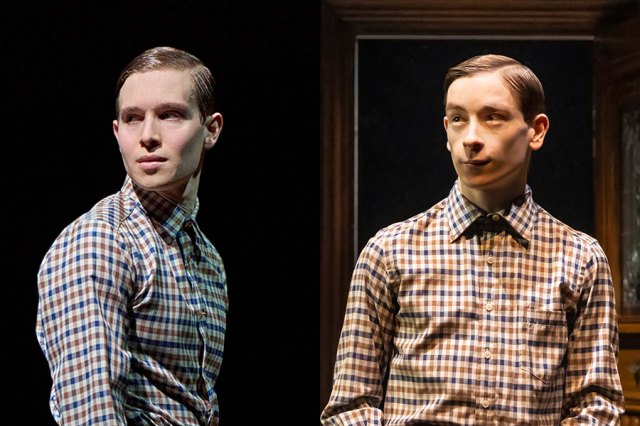
in Red, Hot and Blue
(Photo: Jerry Dalia)
There may not be many musical comedy purists left. I’m talking about folks who insist that nothing of the original script and score be altered when a show is revived. The few hard-liners still with us have had to get used to the rewriting of dated libretti that boast great scores; the rationale is that contemporary audiences expect logical scripts and will balk if crossed.
Michael Leeds has taken so many liberties with the Cole Porter–Howard Lindsay–Russel Crouse tuner Red, Hot and Blue that he must feel like a drunken sailor. Leeds reports that, when he talked to Crouse’s widow about re-mounting the show, he assured her that he wanted to “honor the logical lunacy” of the script. She must have been sold, because all of those concerned with the property rights gave Leeds carte blanche to do what he wanted to do and use what he wanted to use in revising the book and score of Red, Hot and Blue. That’s just what he did for last year’s Goodspeed Opera House revival and has done again this year for an expanded production at the Paper Mill Playhouse in New Jersey, opening tonight.
In the Paper Mill version, which stars Bruce Adler, Debbie Gravitte, and Jim Walton, Leeds has held on to the characters played in 1936 by Jimmy Durante, Ethel Merman, and Bob Hope. When the curtain first went up on the show, Durante was Policy Pinkle, an ex-con; Merman was Nails Duquesne, a manicurist turned society broad; and Hope was a lawyer who had lost his great love when he was six because he was responsible for her being branded on the
butt by an iron. (Yup, you read that right.) To these colorful figures Leeds has added secondary love interests who’ll be played at Paper Mill by Felicia Finley and Michael Gruber. He’s also dreamed up a chorus of convicts and debutantes–“perennial debutantes,” in Porter’s phrase, because they come out every year. For all this tinkering, Leeds’ most noticeable alteration might be the title. When the show opened, it was Red, Hot and Blue! Now, the exclamation point has been excised.
By the way, the original production is famous among cognoscenti of the Great White Way because of the unique manner in which its stars were billed. A dispute between Durante and Merman over who would get top billing was settled when Linda Lee Porter suggested that the names could be criss-crossed. That solution carried when it was also decided that, every two weeks, the name that started at the top left would change. (Apparently, nothing like this has cropped up at Paper Mill, where the entire cast is listed under the title in alphabetical order.)
In adding such songs as “I’ve Got You Under My Skin” to the proceedings, Leeds insists that his decisions were “all driven by character.” As he’s arranged it and Andy Blankenbuehler has choreographed it, the characters are now also driven to sing and dance to “Just One of Those Things,” “You Do Something to Me,” and “It Ain’t Etiquette.” (Bert Lahr and Jean Moorhead introduced the last-named ditty in 1939’s DuBarry Was a Lady.)

(Photo: Jerry Dalia)
As a handful of musical numbers were unfurled at a press event last week, it was clear that Porter’s score didn’t need much tampering with. “It’s De-lovely,” “Down in the Depths,” and “Ridin’ High” were all crafted for Red, Hot and Blue. In reworking the book, Leeds has certainly achieved his goal of remaining true to the logical lunacy of Lindsay and Crouse: Leading into one of Porter’s outrageous double-entendre ditties, “The Ozarks Are Callin’ Me Home,” Policy Pinkle mentions that he was born between two mountains in a town called Cleavage. The line sounds like Lindsay and Crouse, but it isn’t–it’s Leeds.
Maybe rewriting Red, Hot and Blue is nothing to be miffed about in that there is precedent for it. In his 1998 Porter biography of Porter, William McBrien quotes Ray Kelly, a pal of both Cole and Linda, as follows: “Every night, the performance was something else because those three people would come on stage. Hope would carelessly toss a line up in the air and Merman or Durante would grasp it and many strange things would happen, but always funny. Some lesser person would come out and, bang, they would throw them a line having nothing to do with the book. They would sit there dumbfounded and the other three would carry on…kick it around. I don’t think that show repeated itself three times in the whole run.”







